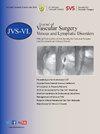Morphofunctional evaluation of great saphenous vein's tributaries after thermoablation: A case series
IF 2.8
2区 医学
Q2 PERIPHERAL VASCULAR DISEASE
Journal of vascular surgery. Venous and lymphatic disorders
Pub Date : 2025-01-01
DOI:10.1016/j.jvsv.2024.101986
引用次数: 0
Abstract
Objective
This study evaluates hemodynamic and anatomic changes in great saphenous vein (GSV) tributaries after endovenous laser ablation (EVLA).
Methods
This case series analyzed 112 areas in 28 lower limbs of 25 patients who underwent EVLA from April 2022 to June 2023 at the Hospital das Clínicas de Pernambuco/UFPE. All patients were evaluated by Doppler ultrasound preoperatively and 3 months after the surgical treatment. The parameters studied were GSV diameter and patency, GSV tributary diameter, patency and flow direction, and the Venous Clinical Severity Score after EVLA. The GSV characteristics were evaluated in four regions: saphenous-femoral junction, medium thigh, knee, and medium leg. The tributary veins were grouped in four areas: anterior thigh, posterior thigh, anterior leg, and posterior leg.
Results
The results included 28 lower limbs from 23 patients; 18 patients (67.9%) were women, and the average age was 49 years; 2 patients were lost to follow-up. Ninety days after EVLA, all treated GSVs were occluded. The average diameter of GSV decreased in all four regions studied: saphenous-femoral junction, medium thigh, knee, and medium leg (P ≤ .001). We analyzed 101 GSV tributaries. In the analysis of GSV tributaries by area, we identified a mean diameter decrease in all groups of tributaries (P < .001). Considering the tributaries with reflux, we also identified a reduction in the number of tributaries with reflux in all four groups (P ≤ .001). All tributaries were patent preoperatively; at 3 months after the surgical treatment, GSV tributaries occlusion was infrequent, except for the anterior thigh group. There was a decrease from 9 to 5 points in Venous Clinical Severity Score after EVLA (P < .001).
Conclusions
This study demonstrated that, after GSV laser ablation, there was a statistically significant decrease in the diameters of all tributary groups, and the number of tributaries with decreased reflux; however, the occlusion of tributaries was not a frequent finding.
热消融术后大隐静脉支流的形态功能评估:病例系列。
目的:本研究评估静脉内激光消融术(EVLA)后大隐静脉(GSV)支流的血液动力学和解剖学变化:本研究评估了静脉腔内激光消融术(EVLA)后大隐静脉(GSV)支流的血液动力学和解剖学变化:本病例系列研究分析了25名患者28条下肢的112个区域,这些患者于2022年4月至2023年6月在伯南布哥临床医院/UFPE接受了EVLA。所有患者术前(PRE)和术后三个月(POS)均接受了多普勒超声(DUS)评估。研究参数包括 GSV 直径和通畅度,GSV 支流直径、通畅度和血流方向,以及 EVLA 术后静脉临床严重程度评分(VCSS)。对四个区域的 GSV 特征进行了评估:隐静脉-股交界处(SFJ)、大腿中段、膝关节和小腿中段。支流静脉分为四个区域:大腿前侧(AT)、大腿后侧(PT)、小腿前侧(AL)和小腿后侧(PL):结果包括 23 名患者的 28 个下肢;其中 18 名(67.9%)为女性,平均年龄为 49 岁;两名患者失去了随访机会。EVLA 治疗后 90 天,所有接受治疗的 GSV 均闭塞。在所研究的四个区域:隐股-股交界处(SFJ)、大腿中部、膝关节和小腿中部,GSV 的平均直径都有所下降(P=< 0.001)。在按面积对 GSV 支流进行分析时,我们发现各组支流的平均直径均有所下降(p< 0.001)。考虑到有回流的支流,我们还发现在所有四组中,有回流的支流数量都有所减少:这项研究表明,在大隐静脉激光消融术后,所有支流组的直径都有统计学意义上的显著下降,有回流的支流数量也有所减少;但是,支流闭塞并不是一个常见的发现。
本文章由计算机程序翻译,如有差异,请以英文原文为准。
求助全文
约1分钟内获得全文
求助全文
来源期刊

Journal of vascular surgery. Venous and lymphatic disorders
SURGERYPERIPHERAL VASCULAR DISEASE&n-PERIPHERAL VASCULAR DISEASE
CiteScore
6.30
自引率
18.80%
发文量
328
审稿时长
71 days
期刊介绍:
Journal of Vascular Surgery: Venous and Lymphatic Disorders is one of a series of specialist journals launched by the Journal of Vascular Surgery. It aims to be the premier international Journal of medical, endovascular and surgical management of venous and lymphatic disorders. It publishes high quality clinical, research, case reports, techniques, and practice manuscripts related to all aspects of venous and lymphatic disorders, including malformations and wound care, with an emphasis on the practicing clinician. The journal seeks to provide novel and timely information to vascular surgeons, interventionalists, phlebologists, wound care specialists, and allied health professionals who treat patients presenting with vascular and lymphatic disorders. As the official publication of The Society for Vascular Surgery and the American Venous Forum, the Journal will publish, after peer review, selected papers presented at the annual meeting of these organizations and affiliated vascular societies, as well as original articles from members and non-members.
 求助内容:
求助内容: 应助结果提醒方式:
应助结果提醒方式:


